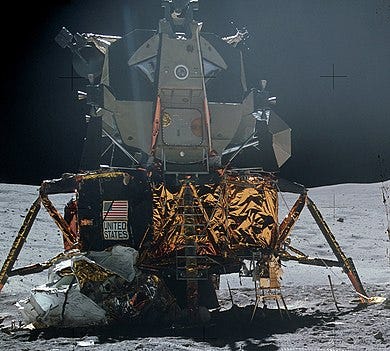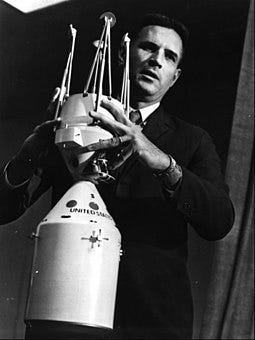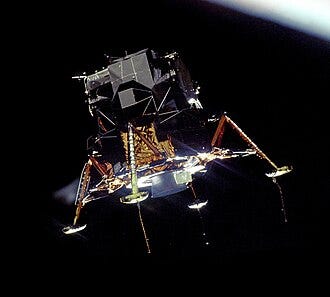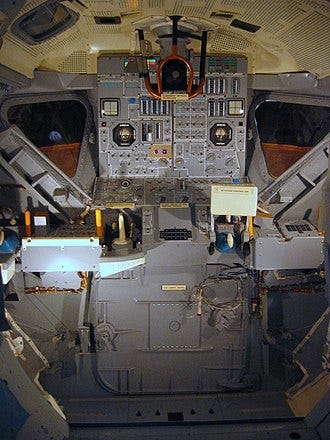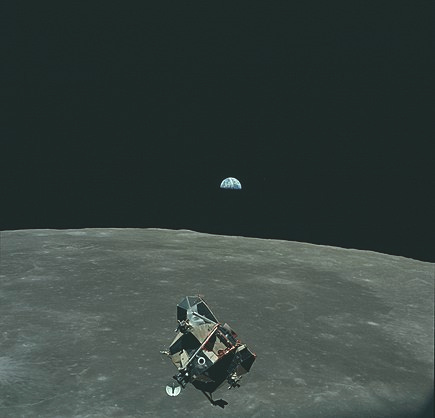While the design of the Apollo CSM was being refined, NASA needed a lander spacecraft. In November of 1962, Grumman was selected to build the Lunar Excursion Module. Grumman had been preparing for this moment since 1960, studying various aspects of a lunar mission and concepts for a lunar lander itself. The leader of the Grumman design team was Thomas Kelly, who had been an advocate of Lunar Orbit Rendezvous.
The specifications called for a two-stage vehicle. A Descent Module would house the engine that would carry two astronauts down to the lunar surface and legs for it to land on. The astronauts would be housed in the ascent module, which had its own engine and would take them from the surface back to the CSM in orbit.
As it would never fly in an atmosphere, there was no need for an aerodynamic shape. It wouldn’t need a heat shield. And it could be built from lightweight materials that would never survive a flight through the atmosphere. The overall weight would become an obsession during the development by Grumman.
Beginning in 1963, Grumman presented three concepts to NASA. The first involved a cone-shaped cabin sitting on a cylindrical section with an engine and three folding legs. The second version had seats, large curved windows, and a forward docking port. It was decided that three legs wouldn’t be stable enough and five would be too heavy, so it became four legs. The windows were far too heavy, the seats were unnecessary in lunar gravity, and the extra docking port wasn’t needed.
Design changes were constant throughout 1964 and 1965 as NASA changed various specifications for the lander missions. By 1966, Grumman was moving towards production. But there were problems. Costs had soared, most of that coming from subcontractors. Ground checkout equipment wasn’t originally up to the task, which had delayed the start of the engine tests at the White Sands Test Facility. The Grumman team designing and building the test equipment was working a 56-hour workweek. Surplus checkout equipment from the Gemini program was shipped to Bethpage.
Delays were of great concern to NASA. Hopes that the first lunar module would be shipped to the Kennedy Space Center in early 1967 faded. Both engines proved problematic, and solutions took time to develop. The ascent stage engine wasn’t deemed ready until more than halfway through 1968. The first vehicles on the production line were all behind schedule. There were problems with the windows, which had to be redesigned, tested, and installed. Stress cracks were found in some of the aluminum structures. They had to be replaced. Wiring problems were found in some of the production models and had to be corrected. Finally, NASA demanded weight reductions of 90 kg (198 pounds) from the spacecraft.
The first production model, LM-1, flew in January of 1968 on the unmanned Apollo 5 mission. Both engines were tested, the descent engine three times and the ascent engine twice. LM-3, the first lunar module that would fly on a manned mission, arrived at the Cape on June 14, 1968. Inspections revealed more than a hundred defects, some of them major. By August, program managers realized that LM-3 wouldn’t be ready to fly in 1968. This problem led to the decision to send Apollo 8 to the moon, instead of using the mission to test the lunar module in Earth orbit. LM-3, renamed Spider, would fly with Apollo 9 in March of 1969.
When the design was finished, the LM looked like no other spacecraft ever built. The ascent stage was an ungainly geometric shape that sat atop the descent stage and contained the crew cabin, as well as the flight instruments and controls. There was a hatch at the top, which allowed for docking with the Command Module, and an EVA hatch at the front. Two triangular windows in the front gave the astronauts a view of the surface, and a window at the top gave the commander a view during undocking and docking maneuvers.
The cabin was designed for two astronauts and had a habitable volume of 4.5m3 (160 cubic feet). Life support was provided for a 48-hour stay on the surface, which was extended to 75 hours on the final three missions. The instrumentation included a wide variety of antennas and a ranging radar for use in docking the CSM. Control of the Lunar Module’s attitude was provided by four sets of Reaction Control system thrusters power by hypergolic Aerozine 50 fuel and nitrogen tetroxide oxidizer. Power was provided by batteries.
The astronauts brought their spacesuits with them from the command module, but the rest of the gear and tools they would use on the surface were stored inside the Lunar Module. At the end of their stay on the moon, the astronauts would leave most of that gear behind to save weight for the rocks and soil samples and exposed film they were bringing back to Earth. The astronauts slept inside on hammocks or the floor.
The most important part of the Ascent Stage was the LM Ascent Engine. “The ascent stage was far more critical,” said Lynn Radcliffe, the Grumman manager at the White Sands facility, “because it had no backup.” It was also powered by the Aerozine 50/nitrogen tetroxide mixture. It was designed and built by Bell, with help from Rocketdyne. It couldn’t be throttled, so it was all or nothing. It wasn’t gimbaled and relied on the RCS thrusters for steering. It could only be fired once, either to lift the astronauts and their samples off after separating from the descent stage on the surface, or if an emergency arose during landing and it was needed for the abort maneuver. If it didn’t work, the crew would die.
The octangular descent stage, covered with gold-colored mylar insulating foil, had four spindly landing legs that expanded outward. The descent stage engine was a highly advanced design at the time, which used Aerozine 50 fuel and dinitrogen tetroxide oxidizer. The engine, built by TRW, was designed to be throttleable and was gimballed to help control direction. The engine used pressurized helium to push the propellants instead of using a much heavier system of turbopumps. A doppler radar mounted on the bottom provided guidance for the landing.
On the surface, it took up a space 31 feet wide and 31 feet deep. It stood an inch over 23 feet high. Leg #1, at the front of the vehicle, had an attached platform (known as the ‘porch’) in front of the EVA hatch and a ladder leading down to the footpad. The other legs had sensors that dangled 67 inches down from the footpads, which signals contact with the surface, at which point the descent engine was to be shut down. Equipment for various experiment packages was stowed in compartments on the side of the LM, as was the lunar roving vehicle used in the final three lunar missions.
Ten test versions and fifteen production model Lunar Modules were built. Two of the test models were flown unmanned on Apollo 4 in November of 1967 and Apollo 6 in April of 1968. Both were destroyed upon reentry to Earth’s atmosphere. The remaining test craft are on display at NASA facilities and museums.
The first production model reached space on the unmanned Apollo 5 test in Earth orbit in January of 1968. The first manned test came on Apollo 9, also in Earth Orbit. Apollo 10 brought a Lunar Module to the moon for a dress rehearsal for landing. The next seven went to the moon for landing missions. The final three of those (Apollo 15, Apollo 16, and Apollo 17) used upgraded versions that carried the Lunar Rover Vehicle and provided for longer stays on the lunar surface.
The Lunar Module used for Apollo 9 burned up on re-entry in the Earth’s atmosphere. The descent stage of Apollo 10 LM crashed on the moon, while the ascent module is in orbit around the Sun. The descent stages from the LM spacecraft used on Apollo 11, Apollo 12, Apollo 14, Apollo 15, Apollo 16, and Apollo 17 remain on the lunar surface. The Apollo 11 ascent stage was left in lunar orbit and eventually crashed. The other five were deliberated crashed into the moon’s surface. The Apollo 13 Lunar Module, which was vital in saving that mission from disaster, burned up on reentry. LM-2 was never flown and is now in display at the Smithsonian National Air and Space Museum. LM-9, which was replaced by an extended duration version for Apollo 15, is in display at the Kennedy Space Center. LM-13, which would have been used on the canceled Apollo 18 mission, was only partially completed and now is on display at the Cradle of Aviation Museum on Long Island. LM-14 and LM-15, for the last two canceled Apollo missions, were never completed.


